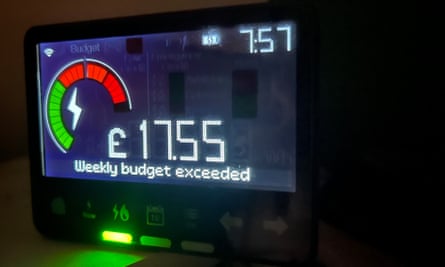
After the late burst of summer heat, the seasons have changed gear abruptly, with heavy rain and cooler evenings signalling the arrival of autumn and the need, once again, to think about how to manage high energy costs during the coldest months of the year.
In the coming days you can expect to receive details from your supplier setting out how your bill will be calculated from 1 October. On that date, the price cap set by the energy regulator for Great Britain, Ofgem, will fall below £2,000 a year, translating into a 7% reduction in average annual energy bills – but the likelihood is that your small print will show that your standing charges are going up, not down.
Standing charges are controversial because, no matter how many jumpers you wear or appliances you turn off, there is little if anything you can do about them. They are flat daily fees, often likened to line rental for your phone, that are charged for a gas and electricity connection and added to your bill regardless of how much or little energy you use.
With the cost of living crisis now into its second year, ever higher standing charges are prompting more people, from MPs to energy bosses, to speak out.
 View image in fullscreenNo matter how many jumpers you wear or appliances you turn off, there is little you can do about standing charges for energy. Photograph: Linda Nylind/The Guardian
View image in fullscreenNo matter how many jumpers you wear or appliances you turn off, there is little you can do about standing charges for energy. Photograph: Linda Nylind/The Guardian
From 1 October the amount these charges add to a typical dual fuel bill will rise to above £300 a year – a substantial figure that some argue unfairly penalises low-income households. They have typically increased by more than 60% in the past two years.
Anita*, 66, became aware of how much the electricity standing charge was costing her when she had a smart meter fitted at her retirement property on the south coast.
“First thing in the morning, it tells me I’ve spent 57p, then at the end of the day, when I go to bed, it tells me I’ve spent £1.07,” she says.
Anita says she can afford the charge – she keeps her energy use down “to save the planet rather than pennies” – but adds that this also underlines problems with the flat daily cost. “With a variable charge, people are incentivised to use less electricity.”
The price cap only limits the unit cost of gas and electricity and standing charges, not the total bill, which relates to how much energy you use. Under the current cap, customers who pay by direct debit are charged a maximum of 30p a kilowatt hour (rounded to the nearest penny) for electricity and 8p a kWh for gas.
When the cap is cut next month, those unit costs will fall to 27p and 7p respectively. Average daily standing charges, now at 52.97p for electricity and 29.11p for gas, will nudge up to 53.37p and 29.62p.
While falling unit costs are good news for households, campaigners say they are unlikely to feel much better off. The cost of every unit of energy used is still about double what it was two years ago. Meanwhile, standing charges are up 8% for gas and a whopping 119% for electricity, according to the End Fuel Poverty Coalition.
We’d like to see the regulator fix this by moving more costs from standing charges on to unit ratesOctopus Energy’s Greg Jackson
Compared with last winter, unit costs are down 30% for gas and 15% for electricity, it says, but standing charges are up 4% for gas and 15% for electricity. There will also be no repeat of last year’s universal £400-a-household bill subsidy, which covered about 16% of an average bill.
Among those speaking out against standing charges is Greg Jackson, the founder and chief executive of Octopus Energy, who says they “disproportionately impact lower-income households”.
He says: “It’s hard to justify a meter racking up hundreds of pounds a year even when there’s hardly any usage. We’d like to see the regulator fix this by moving more costs from standing charges on to unit rates, so that those who use less don’t get penalised.”
The money raked in by standing charges covers non-energy costs in the industry – things such as maintaining the infrastructure that gets electricity and gas to homes, billing and fitting smart meters. They have also helped pay for cleaning up the mess after 30 suppliers went bust during 2021 and 2022.
Simon Francis, the coordinator of the End Fuel Poverty Coalition, agrees that standing charges are unfair, not least because of big regional variations, with energy users in Merseyside and north Wales paying substantially more than those in south-east England.
“In an ideal world, you would get rid of standing charges and move things on to the unit cost but you should only do that if there is a fairer way of charging for energy, especially for people who are more vulnerable,” Francis says.
“This is where ideas such as a social tariff for energy start to come in. Then you could safely move costs on to the unit charges because vulnerable groups [on the tariff] would be paying less. At the moment, we don’t have anything like that. The government was supposed to run a consultation on it this summer but failed to do so.”
 View image in fullscreenStanding charges are added to your bill regardless of how much or little energy you use. Photograph: Trudie Davidson/Getty Images
View image in fullscreenStanding charges are added to your bill regardless of how much or little energy you use. Photograph: Trudie Davidson/Getty Images
Anita has written to Ofgem, asking it to look at alternatives to the current system, which she says is “ripping off little old ladies”.
She says: “I estimate that for average households, the fixed charge makes up less than 10% of their bill. Surely a single-old-people-friendly tariff of no fixed charge in return for an increase in the variable rate of 10% or 15% should be imposed on energy companies.”
Inflation is the biggest factor behind recent standing charge increases, reflecting the higher costs incurred by suppliers to provide their services, according to analysts. They point out that firms do not have to raise the daily charges in line with the cap – they can structure their tariffs as they see fit.
The specialist pay-as-you-go firm Utilita, for example, does not impose standing charges at all, instead recouping its costs by charging a higher unit rate.
Bill Bullen, the Utilita founder and chief executive, says its mantra of “no usage, no spend” is appreciated by prepay customers who “feel that standing charges are like a leak in the meter that slowly drains away their credit”.
Ofgem maintains that standing charges “are a valid way of recovering costs”. It says a recent impact study showed that moving costs from the standing charge to a higher unit rate would result in winners and losers, and could be particularly damaging for vulnerable consumers who were unable to reduce their usage because of age, disability or reliance on medical equipment.
“Energy firms have always been free to decide how they structure their tariffs between the two, and we know some suppliers do not have standing charges, instead recovering their upfront costs via the unit rate,” a spokesperson says. However, they add: “We recognise there are households who will be concerned about their bills, including standing charges, and continue to review how costs are passed on to customers.”
Joe Malinowski, the founder of energy comparison service TheEnergyShop.com, says standing charges are a highly contentious issue. “On one hand, they help recover the fixed costs associated with maintaining energy connections to households, which is a not unreasonable. “On the other hand, high standing charges lead to disproportionately higher energy costs for lower energy users who tend to be concentrated amongst lower-income households. Lower income households already spend a much higher share of their income on energy, and this exacerbates that problem. However, there can be no justification for dumping the cost of supplier and regulatory failure onto lower income households as Ofgem has done.”
 View image in fullscreenInflation is the biggest factor behind recent standing charge increases for energy. Photograph: Linda Nylind/The Guardian
View image in fullscreenInflation is the biggest factor behind recent standing charge increases for energy. Photograph: Linda Nylind/The Guardian
The energy crisis has until recently made it impossible to shop around for a cheaper deal, with most Britons currently sitting on their supplier’s default tariff.
However, successive cuts to the price cap mean some competition is returning, and, at the time of writing, Uswitch, the comparison website, had a selection of fixes offering savings of between a measly £1 to £201 (with UW) against the current price cap.
Natalie Mathie, an energy expert at Uswitch, says: “The price of energy for households on standard variable tariffs will fall in October; however, rates are predicted to rise again in January, which is when households use the most energy heating their homes.
“Despite lower unit rates, households will face similar – or, in some cases, more expensive – energy bills to last winter. Only those on fixed tariffs have the certainty of knowing what they will pay for the full term of their deal.”
However, she adds that if you are thinking of switching, you need to pay attention to any exit fees, which could cost up to £200 per fuel. “Also, make sure you look at the unit price and daily standing charge, so you can understand how much you will pay for your energy usage and how it differs from what you are currently charged.”
* Not her real name
Additional reporting by Hilary Osborne

